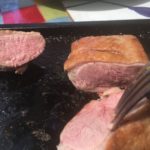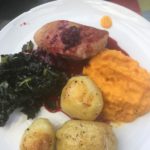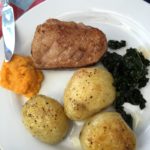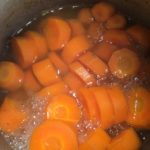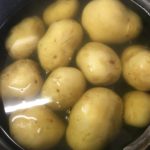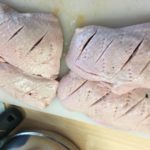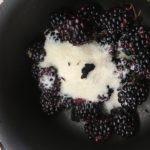I know several people who are passionately fond of eating duck but nervous about cooking it. It’s not hard, providing you stick to a few ground rules:
- Always prick the duck so the fat can drain out – it will make for excellent roasties!
- For the same reason, roast a whole duck on a rack so the fat can render down, unless you’re making confit duck and cooking it from cold in its own fat.
- The objective should always be to leave the skin crispy, whether by roasting, searing or deep frying.
- The breast should always be pink and succulent – overcook duck at your peril!
- Serve it with a fruity sauce to cut through the rich meat, whichever style you use.
On this occasion I cooked duck breasts, easily the leanest cut and pretty easy to do, but the same rule applies – get the timing wrong and you have dull, dry, grey meat with the flavour cooked out of it. Having duck was the starting point, but the next question is how to construct a meal around it.
This being spring, it would be churlish to spurn the local new potatoes available at my nearest farm shop, though my son always prefers his spuds roasted; the compromise is to use the back of a knife to take away the loose skin, boil the potatoes til nearly tender, then roast them lightly (ie. brush with duck fat and allow to cook in a hot oven for 30 minutes. The result is the earthy flavour of new potatoes but a lighter and less oily texture than old roasties.
On this occasion I also took advantage of cavolo nero, black kale as it is also known, and “superfood” as it has become in recent times. Iron and vitamins apart, it’s a very tasty green, all the more so because of the curly leaves. Slice it finely, then steam for about 8 minutes until it tender but a touch al dente.
To provide a colourful contrast to the kale, why not puréed carrots? Also easy to do, providing you have an effective blender. Just chop and cook your peeled carrots until tender, reserving the cooking water. Pop in the blender with a good knob of butter, some sour cream, a twist of pepper and a little of the cooking water, just enough to moisten the purée. It should have a light and frothy texture, be very bright orange and taste highly moreish.
So to the sauce, which in this case was made from a carton of blackberries, the seeds from a vanilla pod, golden caster sugar (not too much of it), a little water and a slug of crème de cassis. Yes, I know cassis is made from black currants rather than berries, but it goes nicely. Bring to the boil and cook so the berries are tender but not broken down into a mush.
Finally the duck. Start by scoring and pricking the skin, as mentioned above. In this case, a dry sauté pan is fine, but heat it until it’s smoking. Give the breasts a good blast, skin side down, pouring off the fat to be used later. When they are crisp and golden, turn them briefly to brown the bottom side, then put on a baking tray in a hot oven for no more than 8 minutes. Any longer and they will lose their juicy pinkness – and as you can tell from the pictures above these were absolutely perfect.
Arrange as artistically as you like on the plate, a good ploy being to slice the duck breasts through so the glorious colour can appetise your guests. Enjoy!


